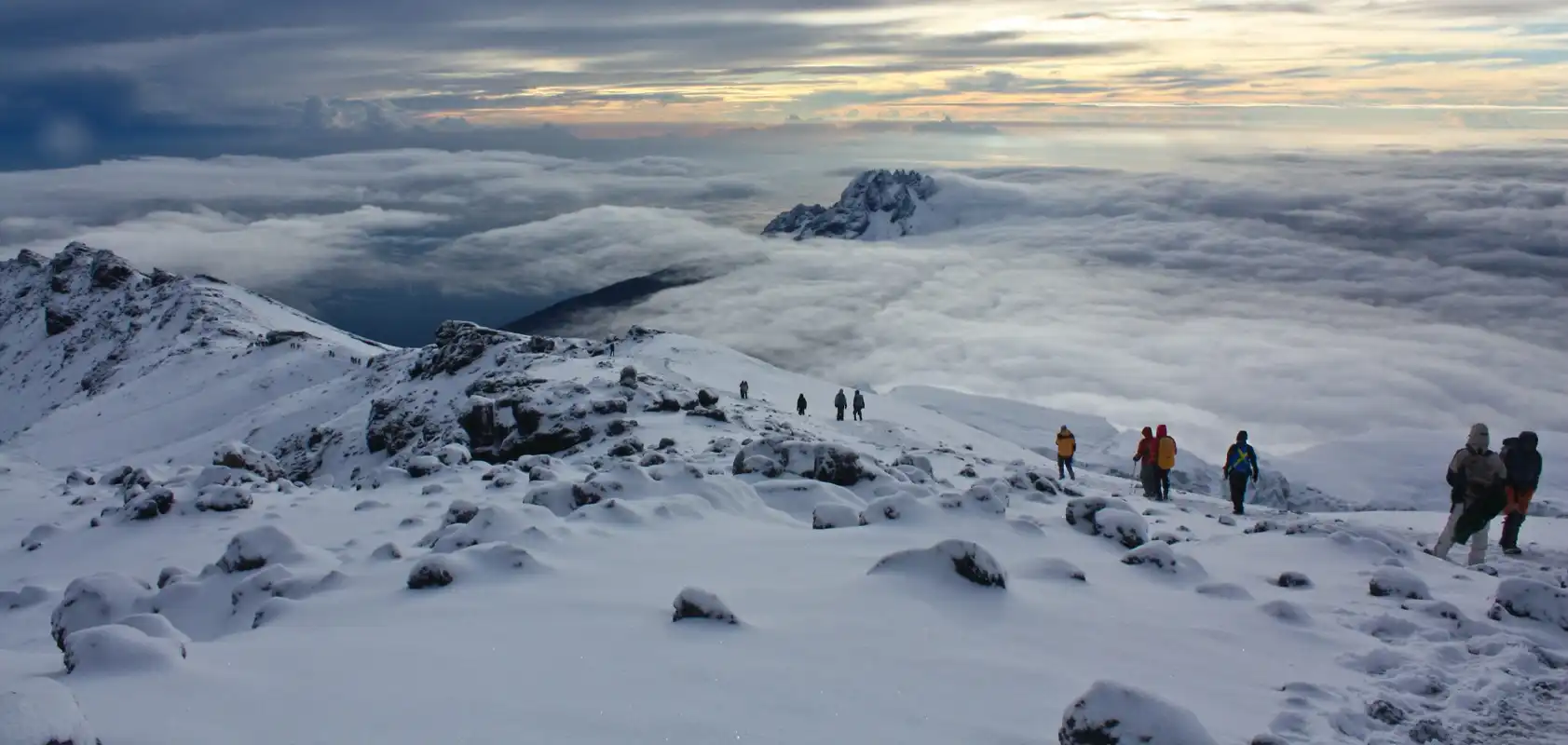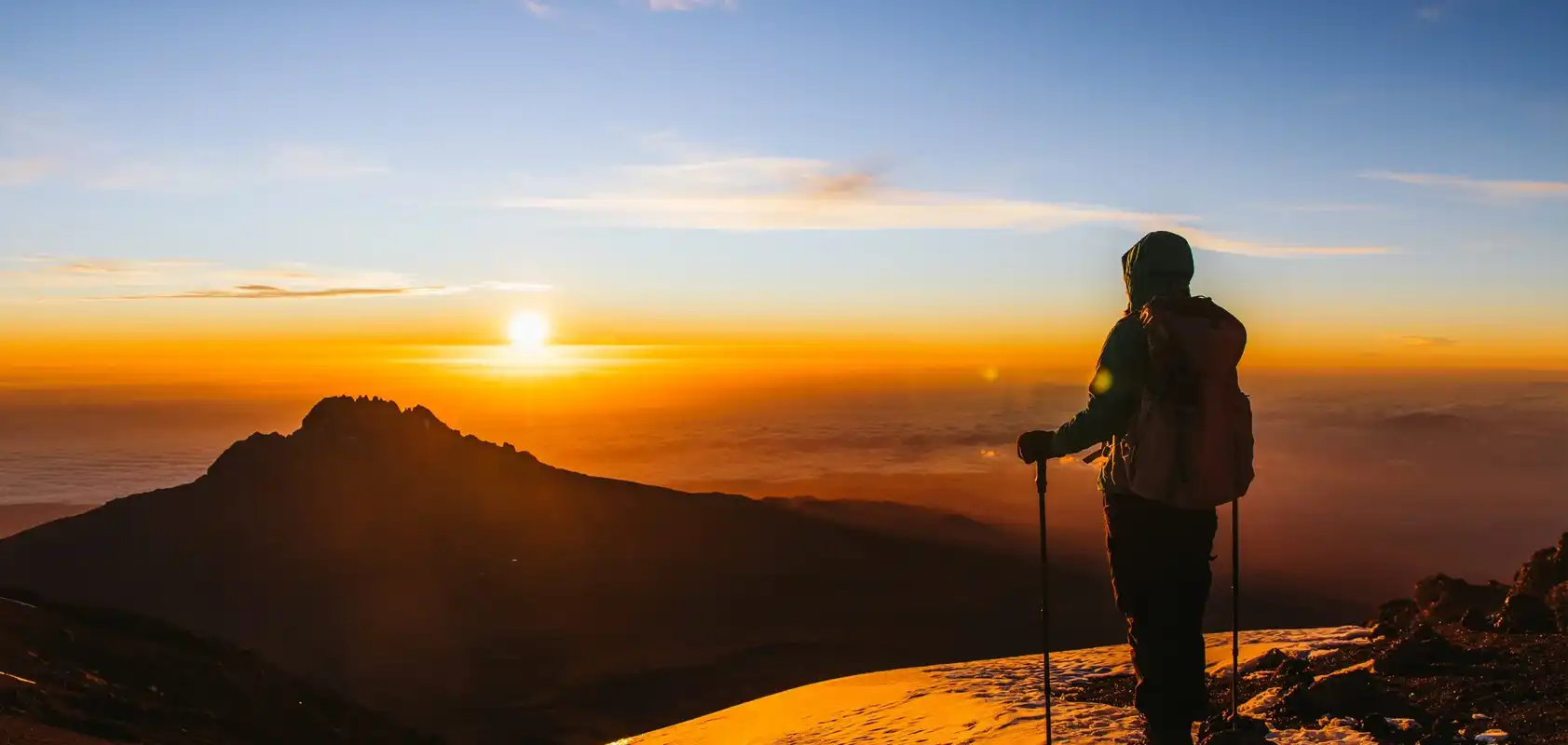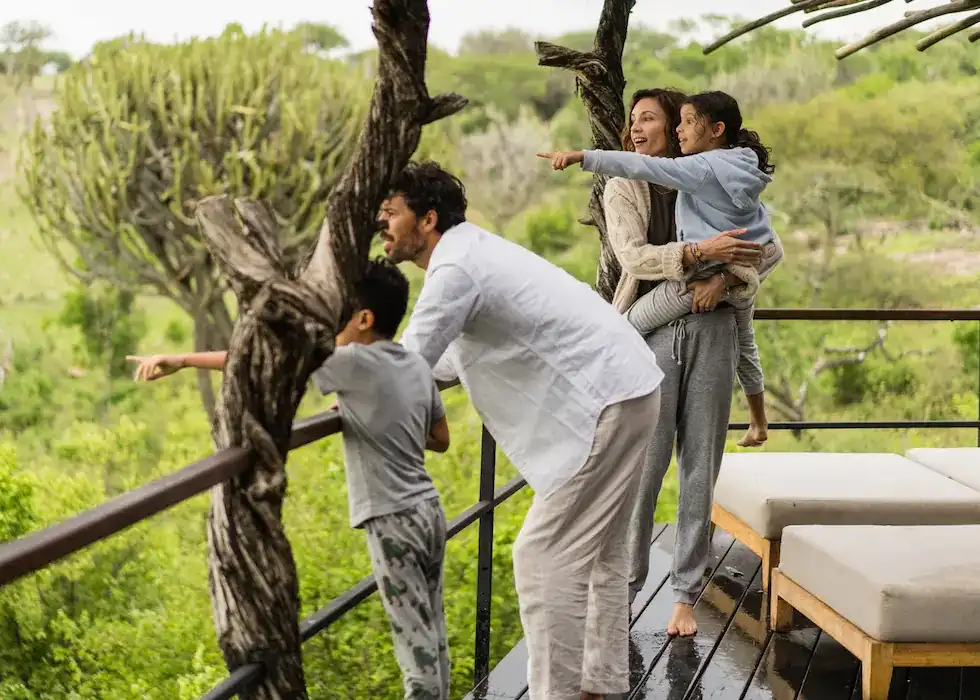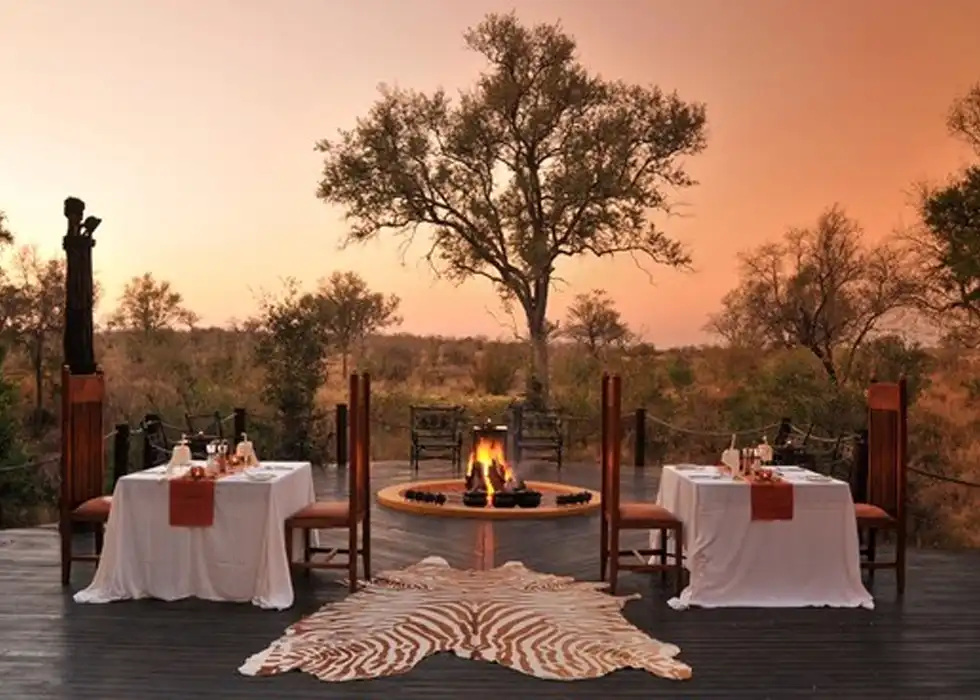Shira Route
Shira Route Overview
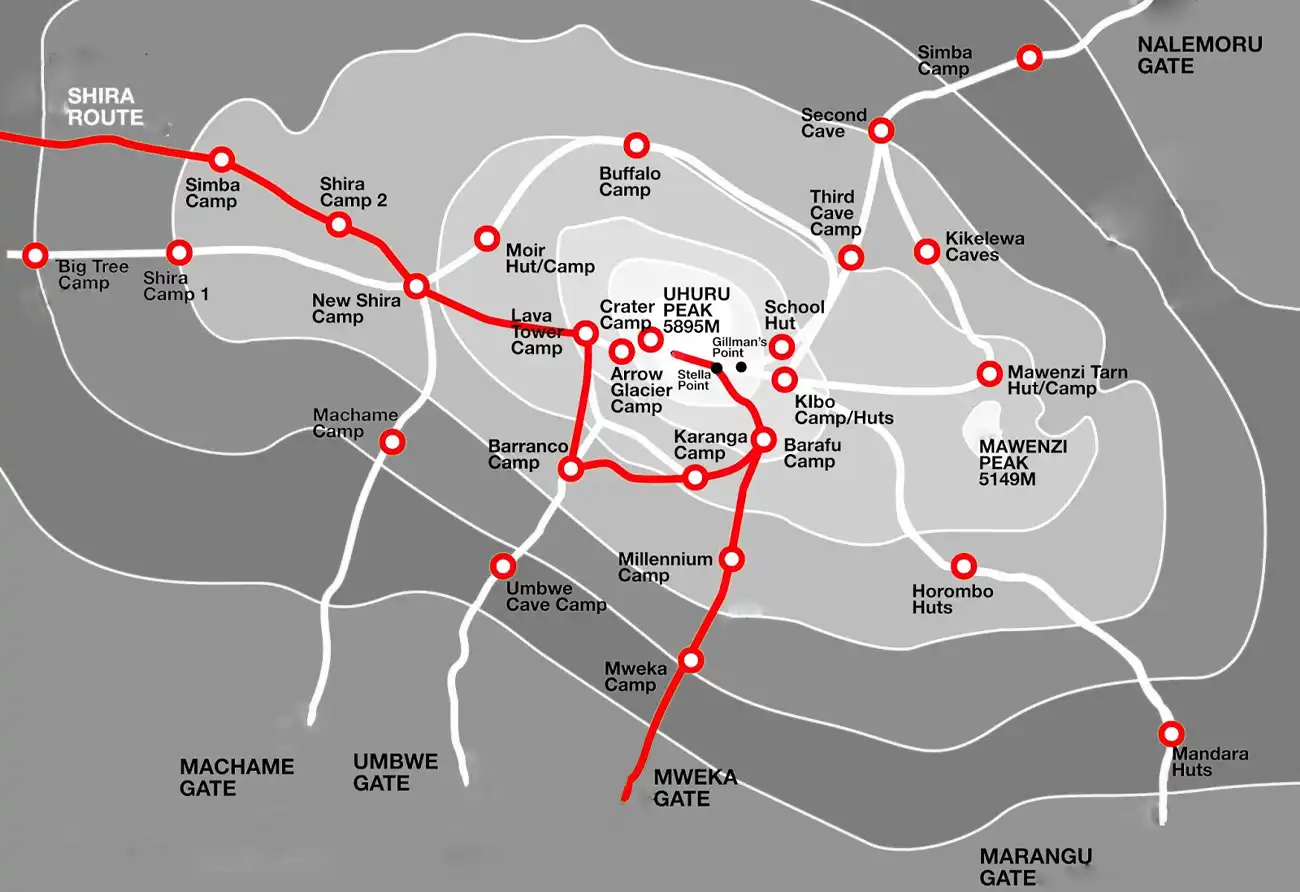
6 Days Shira Route Itinerary
Day 1: Drive to Kilimanjaro National Park Shira Gate, Hike to Shira 2 Camp
Elevation: 1830m/6000ft to 3850m/12,600ft
Distance: 8km/5mi
Hiking Time: 4-5 hours
Habitat: Montane Forest
The drive from Moshi to the trailhead takes about 3 hours. We hike through the rain forest on a winding trail up a ridge. At lower elevations the trail can be muddy and slippery. Gaiters and trekking poles are a good idea here. We continue a short distance until we reach the Shira Camp. An overnight at Shira 2 Camp.
Day 2: Hike Shira 2 Camp to Lava Tower to Barranco Camp
Elevation: 3850m/12,600ft to 4000m/13,000ft
Distance: 10km/6mi
Walking Time: 5-6 hours
Habitat: Semi-desert
From the Shira Plateau we continue to the east up a ridge, passing the junction towards the peak of Kibo. As we continue, our direction changes to the South East towards the Lava Tower, called the “Shark’s Tooth” (elev 4650m/15,250ft). Shortly after the tower we come to the second junction which goes to the Arrow Glacier. We now continue down to the Barranco Camp. Although you end the day around the same elevation as when you began, this day is very important for acclimatization and will help your body prepare for summit day. An overnight at Barranco Camp.
Day 3: Hike Barranco Camp to Karanga Camp
Elevation: 4000m/13,000ft to 4050m/13,250ft
Distance: 5km/3mi
Hiking Time: 34 hours
Habitat: Alpine Desert
After breakfast, we leave Barranco and continue on a steep ridge up the Barranco Wall to the Karanga Valley and the junction which connects with the Mweka Trail. An overnight at Karanga Camp.
Day 4: Hike Karanga Camp to Barafu Camp
Elevation: 4050m/13,250ft to 4700m/15,350ft
Distance: 4km/2mi
Hiking Time: 3-4 hours
Habitat: Alpine Desert
We continue up to the Barafu Camp. You have completed the South Circuit, which offers views of the summit from many different angles. Here we make camp, rest, enjoy dinner, and prepare for the summit day. An overnight at Barafu Camp.
Day 5: Hike Barafu Camp to Summit, down to Mweka Camp
Elevation: 4700m/15,350ft to 5895m/19,340ft
Down to 3090m/10,150ft
Distance: 5km/3mi up / 13km/8mi down
Hiking Time: 5-7 hours up / 5-6 hours down
Habitat: Stone scree and ice-capped summit
Very early in the morning (midnight to 2 am), we continue our way to the summit between the Rebmann and Ratzel glaciers. You head in a northwesterly direction and ascend through heavy scree towards Stella Point on the crater rim. This is the most mentally and physically challenging portion of the trek. At Stella Point you will stop for a short rest and will be rewarded with the most magnificent sunrise you are ever likely to see. Faster hikers may view the sunrise from the summit.
From Stella Point, you may encounter snow all the way on your 1-hour ascent to the summit. Once at Uhuru Peak you have reached the highest point on Mount Kilimanjaro and the continent of Africa!
From the summit we begin our descent by continuing straight down to the Mweka Camp, stopping at Barafu for lunch. You may want gaiters and trekking poles for the loose gravel going down. We arrive at Mweka Camp and enjoy our last evening on the mountain. An overnight at Mweka Camp.
Day 6: Hike Mweka Camp to Mweka Gate, drive to Moshi
Elevation: 3090m/10,150ft to 1680m/5500ft
Distance: 10km/6mi
Hiking Time: 3-4 hours
Habitat: Forest
After breakfast we continue the descent down to the Mweka Park Gate to receive your summit certificates. At lower elevations, it can be wet and muddy. Gaiters and trekking poles will help. Shorts and t-shirts will probably be plenty to wear (keep rain gear and warmer clothing handy).
Kilimanjaro Climbing FAQ’s
Certainly! Here are some frequently asked questions (FAQs) about Kilimanjaro Climb:
How high is Mount Kilimanjaro?
Mount Kilimanjaro stands at 5,895 meters (19,341 feet) above sea level, making it the highest peak in Africa.
What is the best time to climb Kilimanjaro?
The best times to climb Kilimanjaro are during the dry seasons, which are from January to March and June to October. These months typically offer clearer skies and more stable weather conditions.
How long does it take to climb Kilimanjaro?
The duration of the climb depends on the route chosen, but most treks take between 5 to 9 days to complete. Longer durations allow for better acclimatization and increase the chances of successfully reaching the summit.
Do I need to be an experienced climber to climb Kilimanjaro?
No prior climbing experience is necessary, but a good level of physical fitness and mental preparation are crucial. Many climbers successfully reach the summit with the help of experienced guides and proper training.
What is altitude sickness, and how can I prevent it?
Altitude sickness, or acute mountain sickness (AMS), is a condition caused by the body's inability to adjust to the decreased oxygen levels at high altitudes. To prevent it, climbers should acclimatize gradually, stay hydrated, and consider taking altitude sickness medication if recommended by a healthcare professional.
What gear do I need to climb Kilimanjaro?
Essential gear includes sturdy hiking boots, warm clothing layers, a sleeping bag rated for cold temperatures, a headlamp, trekking poles, and a backpack. It's also important to have proper high-altitude gear like insulated jackets and gloves.
Which route should I take to climb Kilimanjaro?
There are several routes to choose from, each offering unique experiences and varying degrees of difficulty. Popular routes include the Machame Route, Marangu Route, Lemosho Route, and Rongai Route. The choice depends on factors such as your fitness level, budget, and preferences for scenery and solitude.
Do I need a guide to climb Kilimanjaro?
What accommodation options are available during the climb?
Accommodation on Kilimanjaro typically consists of tented campsites along the trekking routes. Some routes, like the Marangu Route, offer basic mountain huts with bunk beds. Luxury options, including premium tented camps, are available on certain routes for those seeking more comfort.
Is it safe to climb Kilimanjaro?
Climbing Kilimanjaro is generally safe when proper precautions are taken, such as choosing a reputable tour operator, acclimatizing adequately, and following safety guidelines. However, it's essential to be aware of the risks associated with high-altitude trekking, including altitude sickness and adverse weather conditions.
Speak To an Expert
Get advice and suggestions to make this your perfect trip.
Call: +41 774 84 047
Let's Chat on WhatsApp
DESIGN A TOUR
Mount Kilimanjaro Climbing Guide
Here, we’ve compiled crucial insights to prepare you for your Kilimanjaro climb. Find valuable hints, tips, tricks, and recommendations in our comprehensive guide, all offered free of charge. Dive in!
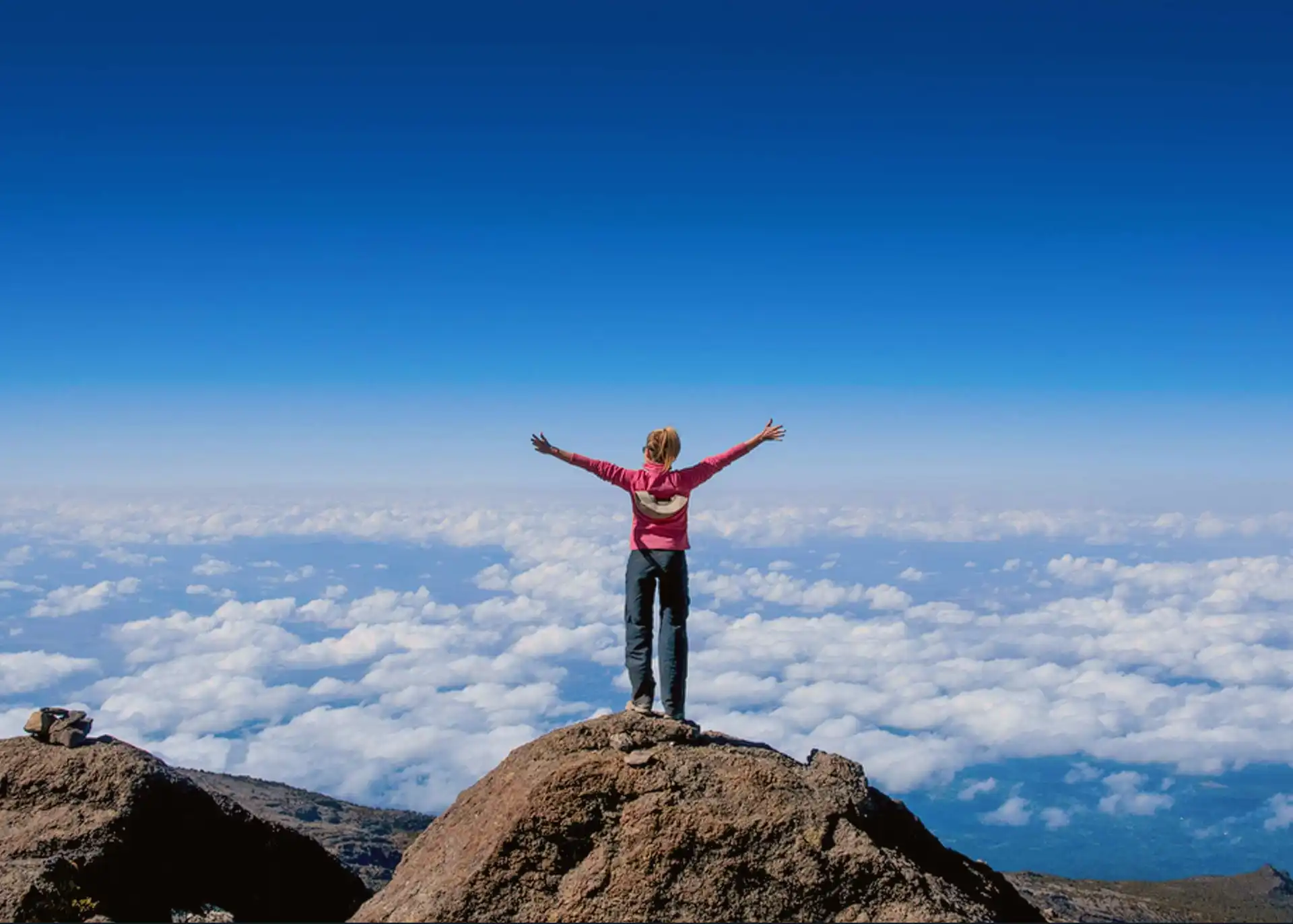
DISCOVER EXCLUSIVE TANZANIA SAFARIS
Tanzania Safari
Journey through the heart of Tanzania's wild landscapes with our expertly guided safaris
Kilimanjaro Climbing
Standing at 5,895 meters, the summit of Kilimanjaro is the highest point in Africa
Design your own trip
Let's Customize a Tour Based on Your Budget and Your Style


